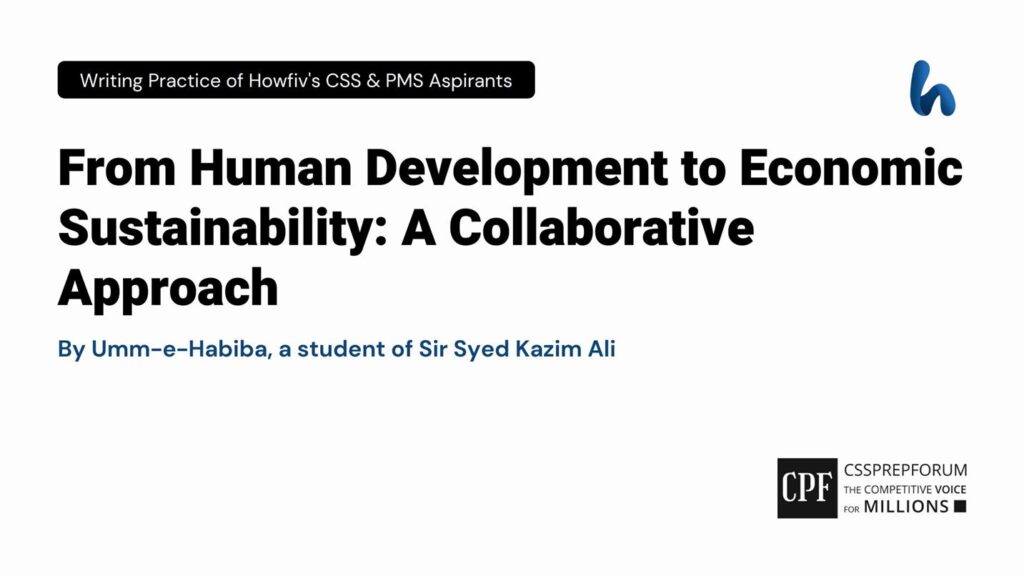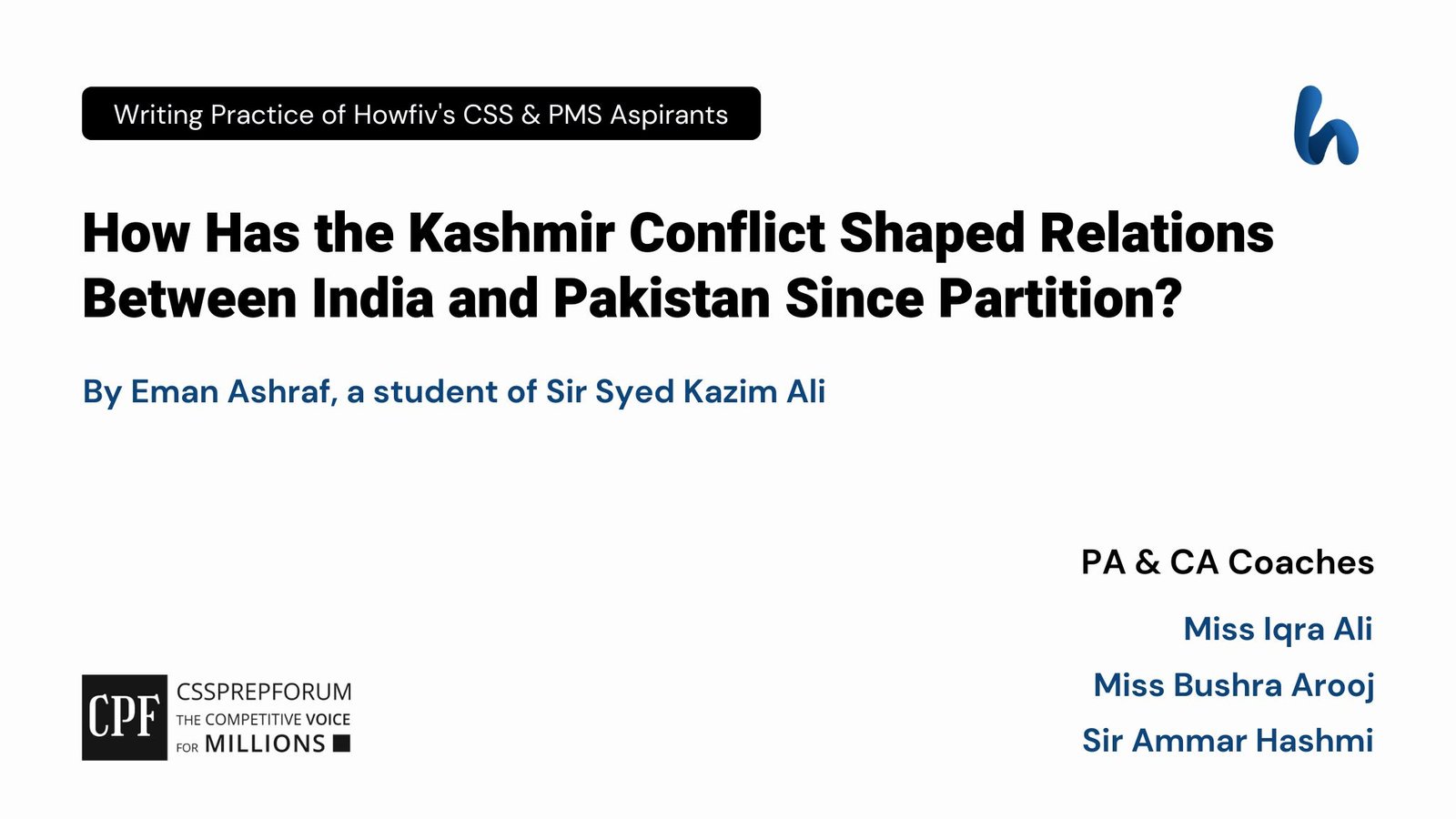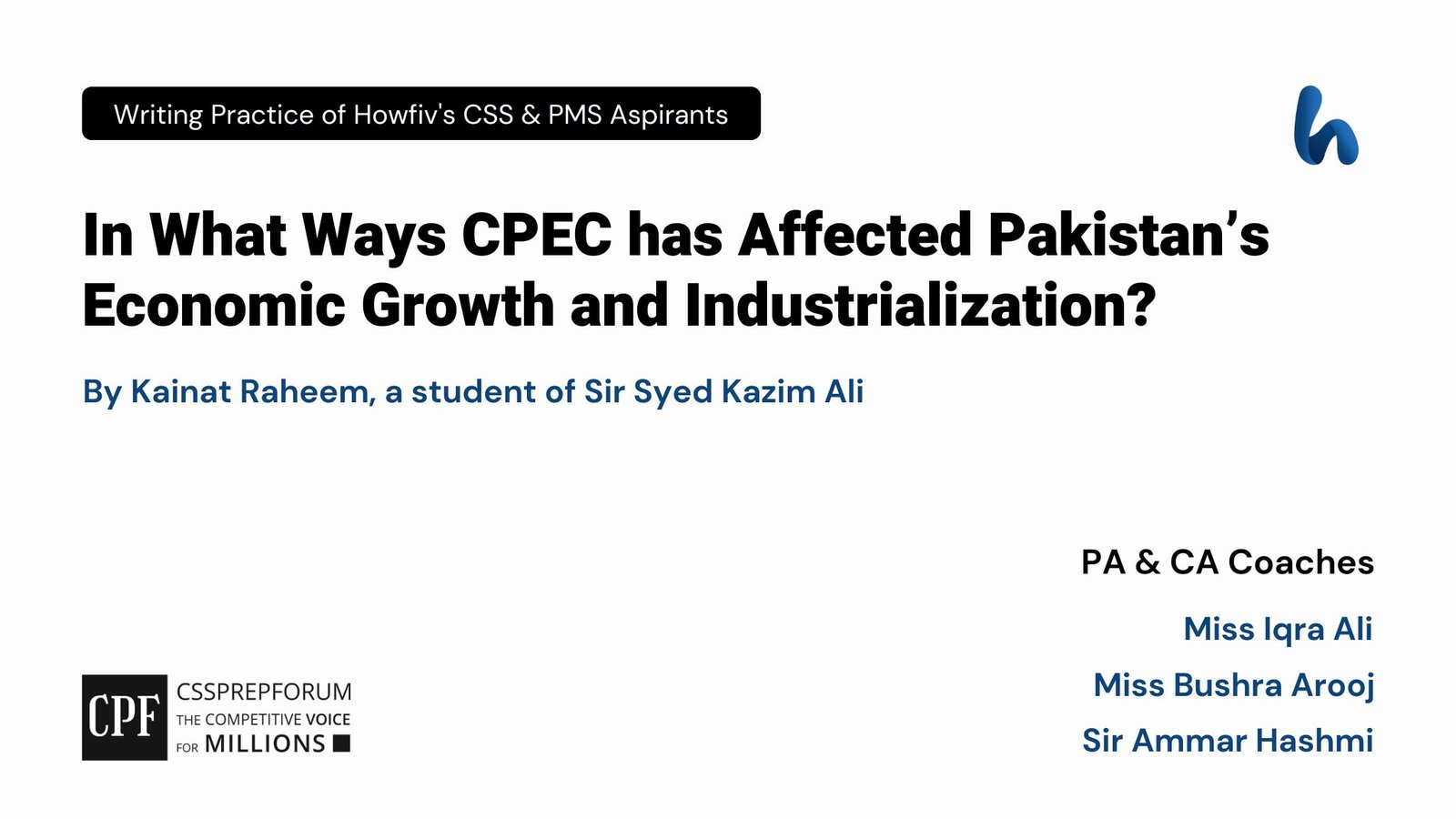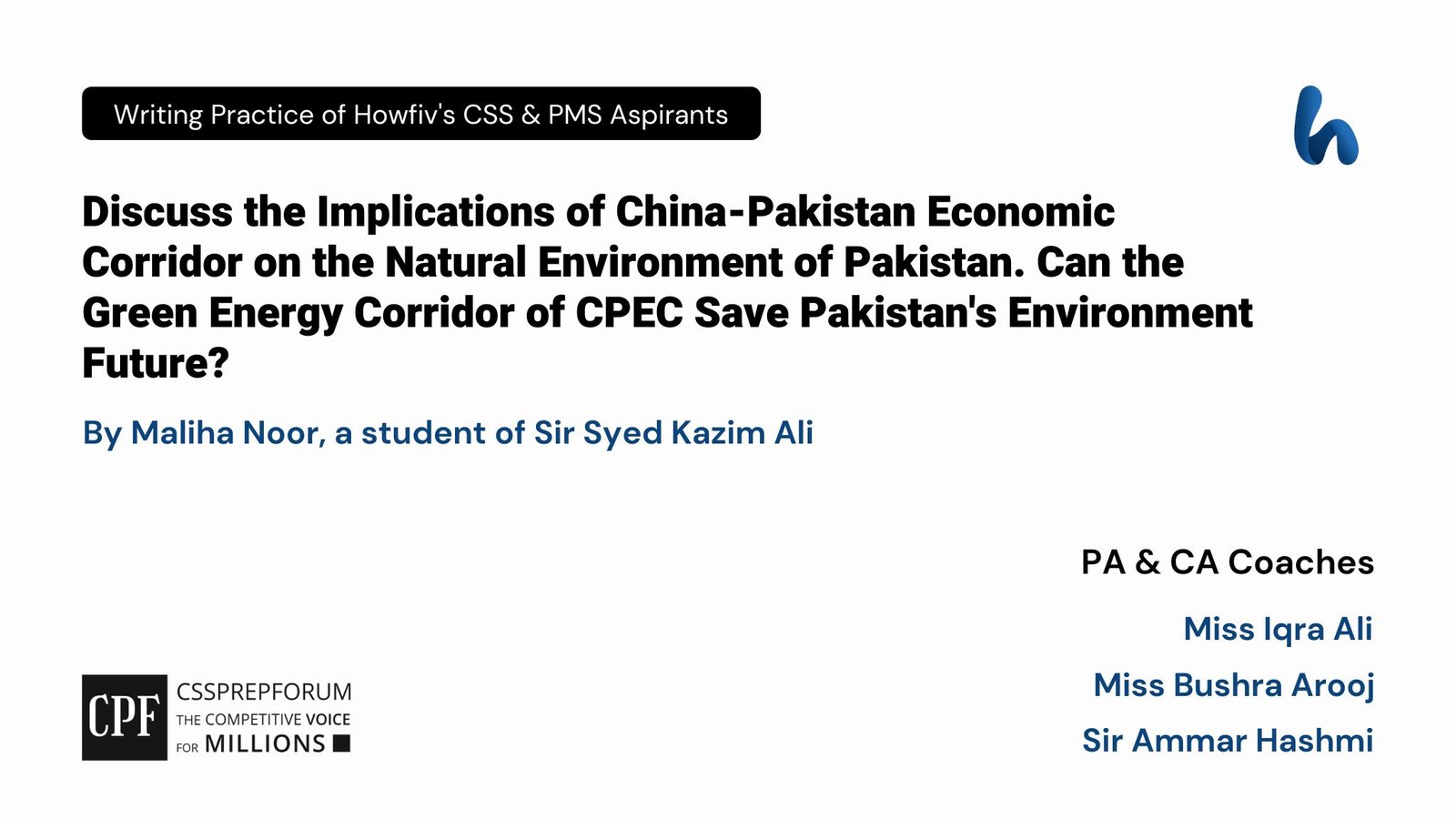The following article is written by Umm-e-Habiba, a student of Sir Syed Kazim Ali. Moreover, the article is written on the same pattern, taught by Sir to his students, scoring the highest marks in compulsory subjects for years. Sir Kazim has uploaded his students’ solved past paper questions so other thousands of aspirants can understand how to crack a topic or question, how to write relevantly, what coherence is, and how to include and connect ideas, opinions, and suggestions to score the maximum.

Introduction
An independent, socioeconomically self-sufficient and enlightened population is a precondition for the holistically sustainable progress of a nation. That is precisely the mantra of the notion of human development and economic sustainability. However, overcoming underdevelopment requires building a human economy that places people at the center of the development process and the measure of progress. Therefore, it focuses more on some foundational elements that serve as the determinants of the economic stability of a country; to illustrate, education, digital literacy, knowledge economy, health, and quality living standards are some of the key areas of human development that ultimately gives momentum to economic growth in a country. Keeping in view all these viable and long-term outcomes of human development, several countries have successfully transformed their human population into human capital. On the flip side, many countries still remain oblivious to this indispensable part of economic growth and thus are left behind in the comity of nations. Therefore, investment in human development would bring peace, prosperity, and stability because of an upward economic trajectory.
Theoretical Underpinning of Human Development and Economic Sustainability: Dr Mubarak Ali and Amartya Sen’s Human Development Model
Taking a glance over the theoretical understanding of human development and economic sustainability from Dr Mubarak Ali and Amartya Sen’s viewpoints, the human development and economic sustainability propounders, it is a pathway to attain the pinnacle of economic growth. According to them, this model urges the government to take measures to develop human capabilities by investing primarily in the population’s education, health, and quality living standards. Furthermore, the UNDP translated this theoretical notion into a practical step when it initiated its human development index to gauge countries’ international standing in critical areas of human development.
How human development leads to economic sustainability?
- Educating the masses enhances labour productivity
The first and foremost factor explaining the maxim is education is the congenital right of every single individual. Therefore, providing free and equal education to all would unequivocally make the populace productive and efficient; subsequently, the whole country can reap the benefits of this human resource. According to the World Bank, “In the USA alone, GDP can increase by $32 trillion, or 14.6 per cent, provided all students are brought up to essential mastery by the National Assessment of Educational Progress standards.” Therefore, investment in the education sector brings economic dynamism, eventually bringing economic sustainability.
- Integrating digital literacy fosters technological advancement
Moreover, the dawn of the 21st century has witnessed a surge in the tech-based economy that has only been possible because of the government’s focus on enhancing the digital literacy rate. Indeed, the tech-savvy human resource has drastically transformed the world economy through e-commerce, freelancing, and entrepreneurship. According to the Mickensy Institute, “Digital literacy will increase the global GDP by 2.3 trillion US dollars by the end of 2030.” Hence, a more budgetary allocation to arm the citizenry with the arsenals of modern tech-based education would pay off tremendously.
- Prioritizing research and development ventures for the educated youth stimulates innovation
Further, it is an open secret that establishing research and development ventures for the educated youth stimulate innovation; as a result, this innovative and skilled workforce vehemently propagates a knowledge-based economy that is more efficient and viable concept, and it ensures the economic growth of a country in a sustainable way. For instance, under the umbrella of China’s Digital Silk Road, Chinese firms are bringing additional benefits to developing countries by establishing training centers and research and development programs to and to transfer technical knowledge in areas, such as smart cities, artificial intelligence and robotics, and clean energy, among others. Hence, the world is heading towards a human economy, which is the true emblem of economic sustainability.
- Establishing a vocational training institute turns the population into a human resource
In addition, the trained and skilled labour is the sine qua non for a country’s economic progress, and such a labour force can only be garnered by establishing vocational training institutes that help the population skill, reskill and upskill themselves to stay relevant with the changing global economic dynamics. According to the Global Economic Benefits of Investment in Vocational Education and Training, in 2010-2011, “The UK government invested £1.2 billion into apprenticeships, and 2010 saw a total economic impact of £25.3 billion.” Thus, a trained labour force is essential for upward economic growth patterns.
- Investing in the health sector help the citizens become resilient and fit for the future endeavors
Next, the recent global pandemic, COVID-19, has unraveled the precarious situation of health infrastructure across the globe; indeed, it has changed the landscape of the health system and up bring a sound healthcare system in place. A report, “Prioritizing Health: A Prescription for Prosperity”, found an economic return of between $2 to $4 across developing countries for every $1 invested in health. As an illustration, healthier children would benefit more from education and grow into healthier adults with higher earnings potential, encouraging investment in education and productive capacity. Prioritizing health can be a catalyst for a broader virtuous cycle of growth.
- Providing better living standards make the populace satisfied, and life expectancy increases
Lastly, the Human Development Index (HDI) measures the decent standard of living using the Gross National Income (GNI) per capita. This quality of living standard helps the country march towards economic progress as envisaged by the economically prosperous status of the countries that are the top scorers in the aforementioned index. According to the UNDP, “Scandinavian countries have an HDI score of 0.8 or above, landing them in the high human development tier.” Indeed, these countries have stable governments, widespread, affordable education and healthcare, increased life expectancies and quality of life, and growing, powerful economies.
Case studies of countries that have been able to transform their human population into a human capital successfully
Talking about various countries that transform their human population into a human capital successfully, Singapore is one of them that have transfigured their economic miseries into economic contentment by following the same human resource management model. To illustrate, Michael Hill and Lian Kwen Fee, in their seminal work “The Politics of Nation Building and Citizenship in Singapore”, defined this individualist model of citizenship as being “emancipatory, expansionary and centered on the autonomous individual”. On the face of it, this concept empowers the citizenry and appears as the vanguard of their rights and economic prosperity. Likewise, South Korea is another country now spending the largest share of its GDP on research and development (R&D), which is even more significant than the US and Japan, two of the global innovation leaders based on R&D intensity. Between 1996 and 2015, South Korea’s R&D intensity grew 88.5 per cent, ultimately showing favourable economic outcomes of following this finest model.
Critical Analysis
The human development model has helped many countries become economically self-reliant; by contrast, the GDP growth model needs to specify a mechanism through which the dynamics of rapid growth can be initiated sustainably and prudently. The fundamental problem with this model is that it implicitly considers economic growth to be an end in itself. Humans in such models are only considered as input into the growth process; therefore, it still needs to be successful in achieving the goal of holistic development. Hence, if human beings become the centrepiece of the economic cycle, then the institutional and organizational forms through which growth is conducted become as important as the pace of change that ultimately ensures economic sustainability.
Conclusion
To crystallize the above discussion, the human race is the prime element in a state’s endeavour to achieve economic self-sufficiency, not the other way around. There have been various models of economic growth throughout human history, but the one that is the most sustainable and long-term is the indubitably human development model. The areas that are being focused under this model are the ones that ascertain actual economic development. Therefore, countries investing in education, research and development, health, and up-to-the-mark living standards have attained prestigious positions in the international community because of their unmatchable economic growth.
CSS Solved Past Papers’ Essays
Looking for the last ten years of CSS and PMS Solved Essays and want to know how Sir Kazim’s students write and score the highest marks in the essays’ papers? Then, click on the CSS Solved Essays to start reading them.
CSS Solved Essays
PMS Solved Past Papers’ Essays
Looking for the last years’ solved PMS essays and want to know how Sir Kazim’s students write and score the highest marks in the essays’ papers? Then, click on the PMS Solved Essays to start reading them.
PMS Solved Essays

CSS Solved General Science & Ability Past Papers
Want to read the last ten years’ General Science & Ability Solved Past Papers to learn how to attempt them and to score high? Let’s click on the link below to read them all freely. All past papers have been solved by Miss Iqra Ali & Dr Nishat Baloch, Pakistan’s top CSS GSA coach having the highest score of their students.
General Science & Ability Solved Past Papers
Articles Might Interest You!
The following are some of the most important articles for CSS and PMS aspirants. Click on any to start reading.












